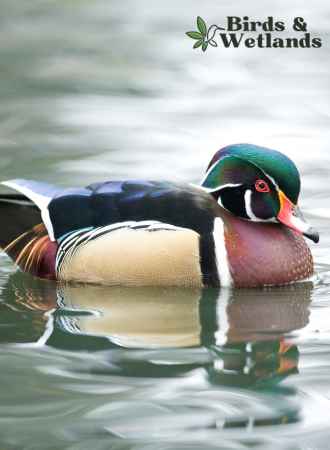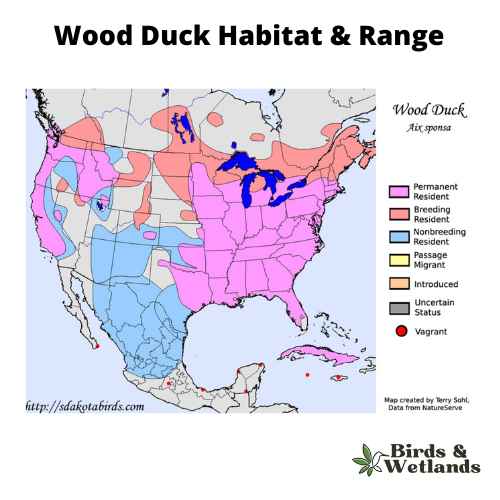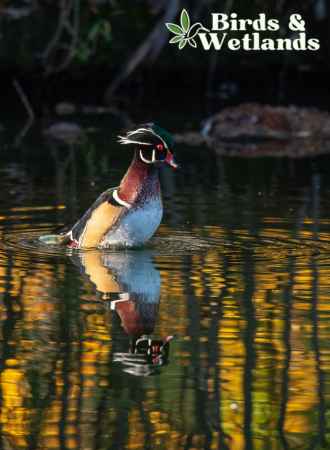The wood duck is a perching duck native to North America. It has sharp claws for perching in trees and logs.
The male wood duck is a colorful and striking bird with a white belly, distinctive crest on its head and a patterned breast and wings.
In the late 19th century, the wood duck population declined significantly due to various factors. One major factor was habitat loss, as the expansion of agriculture and urban development led to the destruction of wetlands and forests, which are essential habitats for wood ducks.
Fortunately, the enactment of the U.S. Migratory Bird Treaty Act and conservation efforts have been made in recent decades to conserve and protect wood duck populations and their habitats. As a result, the wood duck population has rebounded and is considered among North America’s first successful conservation efforts.
The wood duck is closely related to the mandarin duck (Aix galericulata), which is native to East Asia. The two species are sometimes referred to as “sister taxa,” as they are closely related and are thought to have evolved from a common ancestor. However, neither duck is considered to be closely related to any other species of duck found in North America.
Scientific Name: Aix sponsa
Height: 47 to 54 cm (19 to 21 in) ( or 1.5 feet max.)
Wingspan: 66 to 73 cm (26 to 29 in)
Weight: 454-862 g (16.0-30.4 oz)
Physical Description
Male Wood Ducks

The adult male wood duck is a striking and colorful bird with a multicolored crested head that is iridescent green and purple patches with white stripes. Orange eyerings surround its red eyes, its neck is adorned with a distinctive white flare, and it has a chestnut breast.
In the late summer, they lose their colorful plumage and grow gray feathers with blue markings instead.
Female Wood Ducks
The typical adult female wood duck has dull grayish-brown plumage accented by a white-speckled breast and flanks. She has a white eye ring, whitish throat and speculum bordered by a thin strip of white.
Listen to the Wood Duck
Males emit a rising whistle, while females produce a drawn-out, rising squeal.
Habitat

The wood duck prefers to water habitats with trees, extensive cattails or dense vegetative cover consisting of shrubs, herbaceous plants and downed trees. These habitats include wooded swamps, streams, beaver ponds, creeks, rivers, bottomland forests and shallow lakes.
The wood duck is also commonly found in areas with large trees overhanging the water and creating shady conditions and open marshes within a generally forested country.
Range
The wood duck is a species of duck native to North America that breeds in the Pacific Coast in the west and the Atlantic coast in the eastern United States and southern Canada.
Permanent residents of wood ducks are more widely dispersed, with individuals found throughout the central and southern United States and along the Gulf Coast.
In the winter, wood ducks migrate to warmer areas for food and suitable habitat. Their wintering range includes southern California, New Mexico, Arizona, Texas and northern Mexico.
Feeding Habits & Diet

The diet of wood ducks consists of a wide range of foods, including acorns, seeds, aquatic plants, insects, crustaceans, wild celery, aquatic invertebrates and other plant matter. This varied diet allows them to thrive in various habitats, including forests, wetlands, and agricultural fields.
When foraging in water, wood ducks use various techniques to find food. They may take food from the surface, submerge their head and neck to search for food underwater, or even up-end to reach food at the bottom of a body of water.
Nesting & Mating Habits
The breeding season of wood ducks typically takes place from April to July, depending on the location.
These birds prefer to build their nests in tree cavities or nest boxes rather than on the ground like many other duck species. They are often referred to as “tree ducks” due to this behavior.
The nests themselves are typically made out of a combination of moss, grasses, and other plant materials. The females line their nests with down feathers.
Wood ducks typically lay between 7 and 15 eggs per clutch, averaging around 10. The eggs are creamy white and are incubated by the female for an average of 28 to 30 days. Some females may lay eggs in the nests belonging to other females.
Females of the northern population only produce one brood a year, while the females of the southern population can produce two. It is the only North American duck that can do so.
After hatching, the young ducklings climb and leave the nest tree and follow their mother within a day of hatching. The mother calls for her young to follow her. Wood ducklings become fledged at 5 to 6 weeks.
Threats & Conservation Status
The wood ducks are currently evaluated as “Least Concern” by the IUCN. They were in serious decline and virtually disappeared from their former range in the late 19th century. But thanks to conservation efforts, their population began to recover slowly and has bounced back to what it is today.
Hunting

Wood ducks are the one of most hunted waterfowl in the United States, second only to mallards. Daily bag and possession limits vary from one flyway to another.
Key Points
- Wood ducks mostly eat plants, even though they also eat other types of food.
- The wood ducks are the only ducks in North America that can produce two broods in one year.
- Wood ducks are dabbling ducks that dabble food on the water surface.
- A breeding pair of wood ducks use a nest box or cavities of trees close to the water.
- Both adult ducks have crested heads.
- Hours after hatching, the young climb out of the nest and into the water.


